“While
drug distributors have paid a total of $400 million in fines over the past
10 years, their combined revenue during this same period was over $5
trillion.”
“While drug distributors have paid a total of $400 million in fines over the past 10 years, their combined revenue during this same period was over $5 trillion.”
Bush-Era DOJ Report Recommended Felony Charges for OxyContin Execs

A confidential 2006 Department of Justice (DOJ) report recommended three Purdue Pharma executives face felony charges over their concealment and denial of the abuse potential of their now infamous opioid drug, OxyContin, according to a Tuesday New York Times report.
OxyContin, a formulation of the powerful semi-synthetic opioid painkiller oxycodone, is perhaps the prescription pill most closely associated with America’s opioid epidemic. Fueled by decades of widespread pain prescription and intensified by cheap heroin and ever-more-dangerous illegal imported synthetic opioids like fentanyl, the drug crisis is killing Americans on a demographically significant scale — more than traffic deaths and firearm murders combined. Prescription opioids alone led to more than 17,000 overdose deaths in 2016.
Predating the public acknowledgement of the epidemic, there was an intense marketing push for drugs like OxyContin in the 1990s. In 2007, Purdue reached a settlement with the Justice Department over this marketing and the attendant denial of OxyContin’s abuse potential. The company had to pay more than $600 million, and three executives pleaded guilty to misdemeanor criminal charges, performed community service, and paid millions in personal fines.
The New York Times, however, obtained a confidential DOJ report prepared by the federal prosecutors who first worked the case, showing much more serious wrongdoing on the part of Purdue and the three executives — President Michael Friedman, General Counsel Howard Udell, and Medical Director Dr. Paul Goldenheim — than had ever been disclosed before.
In the 120 page report, those federal prosecutors — from the U.S. Attorney’s Office for the heavily-affected Western District of Virginia — recommended the executives be brought up on serious felonies, including conspiracy charges. They based this determination on their findings that internal company documents and emails indicated they knew addicts were stealing OxyContin from pharmacies, crushing and snorting pills, and paying crooked doctors for prescriptions almost immediately after the drug hit the market in 1996. At the same time, the company was aggressively marketing the drug as an alternative that was less attractive to drug abusers.
The executives, meanwhile, testified before Congress in 2001 that they were unaware of OxyContin’s (and its cousin MS Contin’s) abuse potential until 2000.
Eventually, DOJ officials in Washington, under the authority of then-Attorney General Alberto Gonzales, opted not to pursue more serious charges against the men after meeting with them. The New York Times cites a former Drug Enforcement Administration official, Joseph Rannazzisi, claiming the U.S. Attorney in Western Virginia, John Brownlee, was “outgunned” in the decision to settle for misdemeanors, although Brownlee testified that he was “satisfied.”
Purdue, now under different leadership, is by no means out of the legal woods over its opioid marketing. Texas and five other states are pursuing lawsuits against Purdue and other opioid manufacturers over their policies and their relation to the opioid epidemic.
Some commentators, like Conservative Review’s Daniel Horowitz and Breitbart News’s John Hayward, have questioned the wisdom of this aggressive stance, calling the drug companies a “scapegoat” for the nation’s overdose woes and pointing to the availability of cheap street drugs as more pressing.
As fatal overdoses
rise, many Americans
see drug addiction as
a major problem in
their community
Americans overwhelmingly see drug addiction as a problem in their local community, regardless of whether they live in an urban, suburban or rural area, according to a new Pew Research Center survey. The public’s concerns come amid steep increases in the number and rate of fatal drug overdoses across all three community types in recent years.
 Nine-in-ten Americans who live in a rural area say drug addiction is either a major or minor problem in their community, as do 87% in urban and 86% in suburban areas, according to the survey of 6,251 adults, conducted Feb. 26-March 11. Substantial shares in each community type say addiction is a majorproblem, though people in urban and rural areas are more likely to say this than those in a suburban setting (50% and 46%, respectively, compared with 35%).
Nine-in-ten Americans who live in a rural area say drug addiction is either a major or minor problem in their community, as do 87% in urban and 86% in suburban areas, according to the survey of 6,251 adults, conducted Feb. 26-March 11. Substantial shares in each community type say addiction is a majorproblem, though people in urban and rural areas are more likely to say this than those in a suburban setting (50% and 46%, respectively, compared with 35%).
The problem of drug addiction has drawn widespread attention as the United States confronts an opioid epidemic. President Donald Trump last year declared the epidemic a national public health emergency, and statistics from the Centers for Disease Control and Prevention underscore the deadly toll that opioids and other drugs have taken.
Nationally, more than 63,600 people died of a drug overdose in 2016, the most recent year for which full data are available. (Preliminary data suggest the 2017 number will be even higher.) That’s an increase of 21% from the prior year and nearly double the 34,425 drug overdose deaths that occurred a decade earlier. Opioids – ranging from illegal street drugs like heroin to prescription painkillers – have played an especially lethal role: About two-thirds (66%) of the fatal overdoses in 2016 involved an opioid.
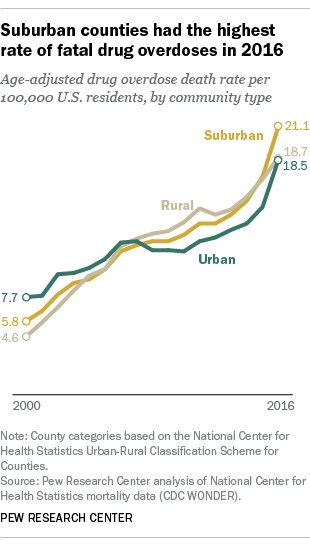 Urban, suburban and rural counties all have experienced significant growth in deadly drug overdoses, according to the CDC. There were 19,172 fatal overdoses in urban counties in 2016, up 25% from the year before. Suburban counties experienced 36,424 such deaths, up 22%, while rural counties saw 8,036 deaths, up 9%. (This analysis uses the National Center for Health Statistics county classification scheme to assign each county to a community type. Pew Research Center used the same approach in its analysis of demographic and economic trends in the new study about American community types. Also, it’s important to point out that not all fatal overdoses are the result of drug addiction. The CDC notes that overdose deaths can have other causes, such as inadvertently taking the wrong drug.)
Urban, suburban and rural counties all have experienced significant growth in deadly drug overdoses, according to the CDC. There were 19,172 fatal overdoses in urban counties in 2016, up 25% from the year before. Suburban counties experienced 36,424 such deaths, up 22%, while rural counties saw 8,036 deaths, up 9%. (This analysis uses the National Center for Health Statistics county classification scheme to assign each county to a community type. Pew Research Center used the same approach in its analysis of demographic and economic trends in the new study about American community types. Also, it’s important to point out that not all fatal overdoses are the result of drug addiction. The CDC notes that overdose deaths can have other causes, such as inadvertently taking the wrong drug.)
Suburban counties not only had the most overall drug overdose deaths in 2016, they also had the highest age-adjusted rate of deadly overdoses – a metric that controls for differences in population size and average age across the three community types. The age-adjusted rate of drug overdose deaths in suburban counties was 21.1 per 100,000 people in 2016, compared with 18.7 per 100,000 in rural counties and 18.5 per 100,000 in urban counties.
Overdose deaths rise sharply among black urban men
 Whites, blacks and Hispanics all have experienced substantial increases in fatal drug overdose deaths in recent years, but there has been an especially large rise among blacks. The overdose death rate for black Americans rose 40% between 2015 and 2016, from 12.2 deaths per 100,000 people to 17.1 per 100,000. Among black men in urban counties, specifically, the fatality rate rose 50% – from 22.6 deaths per 100,000 people in 2015 to 34.0 per 100,000 a year later.
Whites, blacks and Hispanics all have experienced substantial increases in fatal drug overdose deaths in recent years, but there has been an especially large rise among blacks. The overdose death rate for black Americans rose 40% between 2015 and 2016, from 12.2 deaths per 100,000 people to 17.1 per 100,000. Among black men in urban counties, specifically, the fatality rate rose 50% – from 22.6 deaths per 100,000 people in 2015 to 34.0 per 100,000 a year later.
Despite the sharp year-over-year increase among blacks, whites continue to have a substantially higher overall drug overdose death rate (25.3 per 100,000) than both blacks (17.1 per 100,000) and Hispanics (9.5 per 100,000).
In the Center’s new survey, about half of blacks (49%) say drug addiction is a major problem where they live, as do 45% of Hispanics and 40% of whites. Majorities of eight-in-ten or more across the three groups say this is at least a minor problem in their community.
NC Police Find $90 Million in Meth Hidden in Truck Driven by Alleged Illegal Alien

Officials in Linden, North Carolina, discovered 120 gallons of liquid methamphetamine hidden inside the fuel tank of a semi truck being driven by an alleged illegal alien, reports say.
Harnett County Sheriff’s officers pulled the truck over on May 19 and discovered the large amount of the liquefied drug. According to WRAL, the liquid was destined to be turned into 454 kilograms of crystal methamphetamine and would have had a street value of $90.8 million.
The seizure was part of a wider investigation into the trafficking of meth in the area.
The truck was crewed by Raul Topete Arreola, 49, and Aquileo Perez Pineda, 48. Pineda was quickly put on an immigration hold while immigration officials looked into Arreola’s immigration status.
The pair were charged with three counts each of trafficking methamphetamine and placed under a three million dollar bond.
Follow Warner Todd Huston on Twitter @warnerthuston.
nterior Dept. Opioid Task Force Drug Seizure Nets 913.5 Pounds of Illegal Narcotics
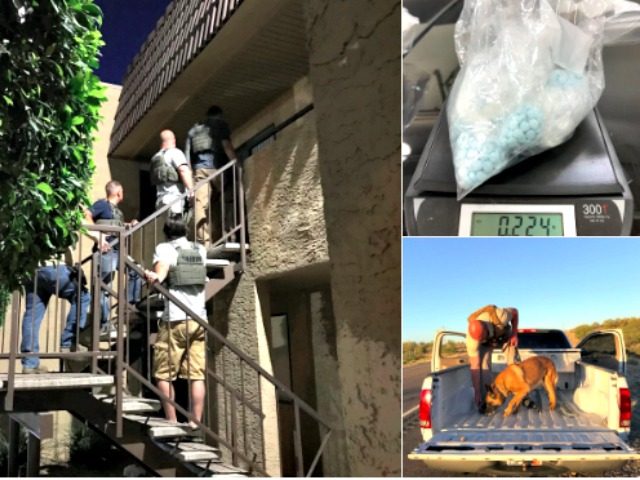
Department of Interior (DOI) Secretary Ryan Zinke announced on Thursday the agency’s Opioid Task Force conducted a major operation around tribal reservations in Arizona, netting a massive seizure of illegal narcotics.
The 11-day investigation conducted between May 15 and May 26 ended with a roundup of more than 9,050 Fentanyl pills, 48.5 pounds of methamphetamine, 1.2 pounds of heroin, 863 pounds of marijuana, and one-half pound of cocaine.
DOI said $30,000 in cash was found over the course of the bust, with the street value of the drugs seized totaling $4,791,417
Eighty-six people were arrested during the operation, according to DOI.
“Our task force on opioids continues to distinguish itself as one of the finest operations in law enforcement today; I could not be more proud of these professionals,” Zinke said in a press release distributed following his appearance Thursday on Fox and Friends, where he announced the operation.
“It’s heartbreaking to see the scale of the problem, and rather than further stigmatizing victims, we are cracking down on the dealers who are selling out our children, selling out our communities, and selling out our nation,” Zinke said.
Zinke thanked the “brave men and women” who took part in the operation and warned drug dealers and traffickers law enforcement officers are “keeping drug dealers up at night.”
“And with good reason; if you are trafficking these drugs, we will find you, arrest you, and bring you to justice,” Zinke said.
“A drug-free Indian Country is a healthy Indian Country,” John Tahsuda, principal deputy assistant secretary for DOI’s Indian Affairs,” said in the press release.
“Only together can we protect our loved ones from the harmful effects of these devastating substances,” Tahsuda said.
“Secretary Zinke has worked with tribes to carry out President Trump’s directive to stop the opioid crisis, conducting dozens of tribal visits to see the affected communities, while listening and learning about how to fight the crisis,” the DOI press release said.
“In starting new initiatives to fight the epidemic, such as the creation of the Joint Task Force, [DOI] is committed to giving all resources required to fight drug abuse,” the release said.
Special Agents from the Bureau of Indian Affairs (BIA), Division of Drug Enforcement (DDE) and BIA K-9 uniformed officers, along with the Tohono O’odham Police Department, Homeland Security Investigations (HSI-Sells, Arizona), U.S. Border Patrol (USBP), Pascua Yaqui Tribal Police Department, San Carlos Apache Tribal Police Department, Gila River Tribal Police Department, Native American Targeted Investigations of Violent Enterprises (NATIVE) Task Force, and the Arizona Department of Public Safety (DPS) took part in the operation, according to DOI.
The Arizona operation is the second led by Interior’s Opioid Task Force, DOI said.
Follow Penny Starr on Twitter
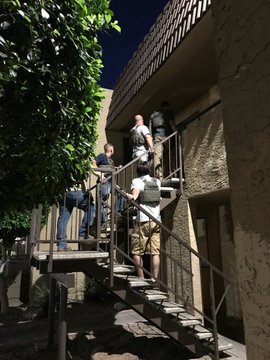
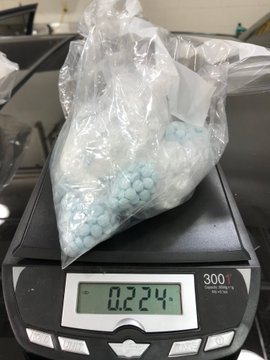
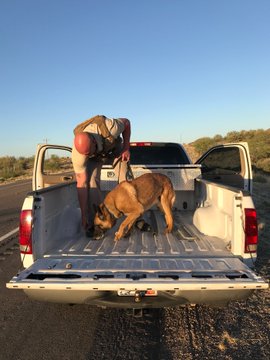

No comments:
Post a Comment